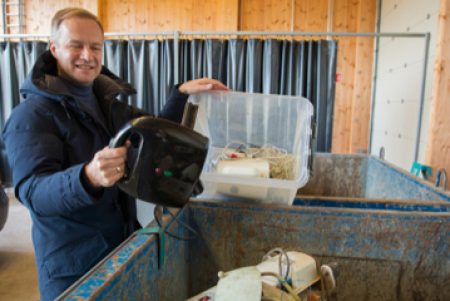- News & Resources: Listings >
- Blog
- 10-Step Patch Management Checklist
- Penetration Testing vs. Breach Attack Simulation
- Current big cyber breaches and impact on businesses
- Smart Infrastructure Gets Lit Up!
- Securing Industrial IoT: The Missing Puzzle Piece
- 7 Common Cybersecurity Mistakes Made by SMBs
- The Future of Physical Security: Cloud-Based Systems
- Autonomous and Sensor Technology Use Surging
- 2024 Facilities Trends Will Require Facilities and IT Teams to Work in Tandem
- NGFW vs. WAF. What’s the Right Firewall for You?
- Chris Hadfield’s Words To Live By
- Industrial Revolution 4.0 + IIoT
- Digital Fluency Drives Innovation
- Your Cloud Needs Protecting, Too
- Your building alarm systems could become obsolete. In 2024!
- Zero Trust 2.0: Zero Trust Data Resilience (ZTDR)
- We just got, or got used to, Wi-Fi 6. What is Wi-Fi 7?
- What Does the Board Need to Know? Business Metrics that CISOs Should Share – 4th and Last in a Four-Part Series
- Why 2024 is the Year for AI Networking
- International Women’s Day is Tomorrow – Great Time to Think About…
- Data-Centric Security Step One: Classifying Your Data
- The Network – Unsung Hero of Super Bowl LVIII
- What Does the Board Need to Know? Business Metrics that CISOs Should Share – Third in a Four-Part Series
- Boosting IT Team Performance by Fostering Intuition, Curiosity and Creativity
- Breach Remediation Costs Can Wipeout Bottom Line and Business
- Hoodied Hackers Now Favour Hugo Boss
- What Do You Need to Tell the Board? Business Metrics that CISOs Should Share – Second in a Four-Part Series
- How to Get People to Re-Engage After the Holidays
- What Does the Board Need to Know? Business Metrics that CISOs Should Share – First in a Four-Part Series
- Android Devices MUST be Updated + IT Departments Being Cut as Privilege Escalation Escalates
- Today’s Common Cloud Migration and Management Concerns
- Protect Your Healthcare Network from Cyberattack – Lives are at Stake
- Happy Halloween: Black Cats Lead to Boo….Hoo.
- Insurance Underwriters are Protecting Their Flanks
- Insurance Companies Cracking Down as Cybercriminals Become Better Business Builders
- Scary Cyberattacks Stats
- Parents, Profs and IT Professionals Perceive Back-to-School Through Different Lens
- Zscaler’s new IDTR and other tools that leverage generative AI
- Vanquish Vaping, Vandalism and Villainy
- Fabric for Fast-Paced Environments
- Changes to Cyber Insurance Requirements – What you Need to Know
- Cybersecurity Readiness – Newly Released Report
- Passwords Leaked…Again
- 10-Step Patch Management Checklist
- Remote – Again – For Now… and Still Maintaining Engagement
- Protecting Pocketbooks, Passwords and Property from Pilfering
- Raspberry Robin: Highly Evasive Worm Spreads over External Disks
- Cisco Introduces Responsible AI – Enhancing Technology, Transparency and Customer Trust
- Managing Customer Trust in Uncertain Supply Chain Conditions
- Hope on the Horizon
- Toys of Tomorrow… What will spark your imagination? Fuel your imagination?
- Protecting Purses and Digital Wallets
- The Password that Felled the Kingdom + MFA vs 2FA
- The MOE’s RA 3.0 and Zscaler
- 7 Critical Reasons for MS Office 365 Backup
- Penetration Testing Important, but…
- Social Engineering and Poor Patching Responsible for Over 90% of Cybersecurity Problems
- Breach Incidence and Costs On the Rise Again + 5 Ways to Reduce Your Risk
- Cybersecurity Insurance Policies Require Security Audits and Pen Testing
- Wireless strategies for business continuity gain importance as enterprise expand IoT, cloud, and other technologies
- How Cybercrooks are Targeting YOU
- Enabling Digital Transformation with Cisco SD-WAN
- WFH Post Pandemic – What It Will Look Like. What You’ll Need.
- Leaders to looking to the IoT to improve efficiency and resiliency
- Cyber Security Vernacular – Well, some of it, for now
- Why You Need Disaster Recovery, NOT Just Back-Ups
- 10 Reasons Why Having an Expert Manage Your Cybersecurity Makes Sense and Saves Dollars
- Converting CapEx IT Investments into Manageable OpEx
- The Hybrid Workplace – Planning the Next Phase
- Cisco Cloud Calling: Empowering Customers to Thrive with Hybrid Work
- When You Can’t Access the Cloud
- How to Keep On Keeping On
- New Cisco Research Reveals Collaboration, Cloud and Security are IT’s Top Challenges
- Threats from Within on the Rise
- Cloud Covered? If Not, Take Cover!
- Zero Trust and Forrester Wave Report
- Password Based Cyber Attack: Like Leaving Keys Under Doormats
- So, What’s Up With Sensors?
- Sensors and Systems Create a Digital “Last Mile” and Help Skyrocketing Costs
- Scanners Provide Peace of Mind for Returning Students and Workers
- Sensors Improve Operations and Bottom Line… Easily and Cost-Affordably.
- Cisco Meraki Looks at 2021
- 2020 Holiday Shopping: Cybersecurity and Other Tips to Safeguard Wallets and Systems
- How to make the most of the technology you have
- Personnel, Planet and Business Progress: More Interdependent Than Ever Before
- Sure… you can get them all in the boat – but can you get them to work well together?
- Pushing the Zero Trust Envelope – Cisco is Named a Leader in the 2020 Forrester Zero Trust Wave
- Cloud Data Must be Protected, Too!
- Don’t Let Anyone Get the Dirt on You – Make It Instead!
- How IoT Devices Can Help You and Your business
- WebEx – A World of Possibility
- Creating Your Breach Response Plan Now Will Save You Thousands Down The Road
- Been hacked? Here’s what you must do next.
- The Need for Pen Testing is At an All-Time High
- 5 Ways an IT Reseller Improves Your Performance and Peace-of-Mind
- 5G and Wi-Fi 6: Faster, more flexible, and future ready. Are you?
- Network and Data Security for Returning and Remote Workers + Disaster Recovery Symposium
- Collaboration and Cisco WebEx: Protecting Your Data
- Thursday’s Virtual Conference Tackles Today’s Supply Chain Trials and Tribulations
- 10 Tips to Reduce Cloud Storage Risk
- COVID-19 Crisis Fuelling IT Spending
- Supply Chain/Logistics Experts Share Their Expertise
- Cisco Breach Defence Overview
- Announcing Our New Website and Blog

Lately, with much news being devoted, understandably, to COVID-19 and the US presidential election, other issues may not have been given the attention they deserve. That doesn’t mean they are any less important to Canadians. Quite the opposite.
Specifically, concerns related to appointment and our environment are critical issues for Canadians of all ages
Three separate pieces of research, including one conducted by TQG in conjunction with the Schulich School of Business in September 2020 and one commissioned by IBM in October 2020, show:
- 50 – 65% of Canadians are more concerned about the environment today, than they were pre-pandemic.
- 70 – 75% of Canadians believe that adoption and utilization of AI, machine learning and other innovative technologies will be critical to ensuring the growth of our economy, and the creation of meaningful jobs, especially for those under the age of 50.
- +70% of Canadians consider both the company’s commitment to the environment and its adoption of technology when seeking employment. This particular stat came from a study conducted before the ongoing impact of the pandemic had been felt from an employment perspective, but is indicative of attitudes. Attitudes that will likely be reinforced once work and career growth returns to normal – whenever that will be, in whatever the new format.
None of this is surprising considering that when the World Economic Form hosted the Sustainable Development Impact Summit from September 1 – 24, 2020, their leaders stated:
“The COVID-19 crisis wreaked havoc on societies and economies and dealt a major setback to achieving the 2030 agenda and the Paris Climate Agreement. Putting the world back on a path of sustainable, equitable and inclusive growth will require more than a global recovery; it will require a great reset of social and economic systems.” (www.weforum.org)
At a time when most companies are still struggling to adapt to new ways of doing business, and seeing bottom-line profits erode in many instances, investing in tomorrow may seem heretical. But, it may be the only way to protect your company’s tomorrow.
An Approach to That Works Well, Regardless of Industry or Organisation Size
- Set aside a time for senior-level leaders to truly examine the business, looking at what products and services have contributed to the company’s growth in the past two years. For each line of business (or SKU), look at its percentage contribution to both profit and revenue, and how that has changed over time – and why.
- Overlay your findings from this internal assessment with trend data related to what’s going on in the macro-environment, changes in your industry overall, and shifts in consumer buying habits and attitudes.
- Be brutally honest with yourselves about what you are doing well, what is off-trend, what is working and what is not.
- Consider what products and services should be eliminated from your portfolio, which ones should be retained and promoted, and what you should be adding to the mix in order to thrive.
- Determine how to reduce your carbon footprint as you make slight – or even major – shifts in direction.
- Determine what organisational changes may be needed in terms of people and process to bring this new strategy to life – and ask yourselves if you have the right people and technologies in place to implement your new vision.
- Calculate what your revenue and profitability will look like five years down the road if you continue on your current path, taking into account the changes around you. Then look at the potential revenue, after factoring in the total investment, if you implement your new approach. In most instances, you’ll find there is a huge upside to making these changes, including more investment in digital transformation.
Repeating a key point from above, as you revisit your products and processes finding ways to reduce resource use and waste can have a profound impact on employee perspectives about the company and your bottom line.
Our key partner, Cisco, refers to this as “Circular Economy”. Interestingly, one of their writers, Katie Schindall, wrote about it on this week. Here are excerpts from that Cisco blog post:
Sometimes referred to as “circularity” or a “closed-loop system,” a circular economy is an economic system focused on the elimination of waste and resource overuse by designing out waste and pollution, keeping products and materials in use, and regenerating natural systems. By reducing consumption and employing principles of repair, refurbishment, remanufacturing, and recycling, we minimize resource use, waste, carbon emissions, and pollution.
The goal of a circular economy is to improve the lifespan and productivity of equipment and infrastructure with the idea that “waste” becomes a resource. (Think composting for servers.) This differs from the traditional linear economy, which is a “take-make-waste” model where products are used and then thrown away.

A circular economy is essential because as a society we’re using more natural resources than our planet can regenerate. It’s also our belief that circular business models can be just as profitable as the old linear model, and we’re on our way to proving that.
Our approach extends from how we design, build, and deliver products to how we value the assets we have and turn those assets into new products. We also apply Cisco technology to support our customers in their own circular transformations. Cisco was a founding partner of the Ellen MacArthur Foundation (EMF), which facilitates collaboration and knowledge-sharing in the pursuit of a circular economy.
In January 2018, Cisco CEO Chuck Robbins joined eight other technology executives at the World Economic Forum in signing the PACE Capital Equipment Pledge. We committed to 100 percent product return, pledging to take back used equipment from any customer and grow the reuse of equipment through refurbishing, remanufacturing, and repair. We continue to actively engage in the PACE Capital Equipment Coalition and other collaborative efforts to advance the circular economy.
We realize that the way we design our products and packaging directly impacts our customers’ ability to achieve their own sustainability goals. Through our circular design strategy, we’re advancing how we can support our customers and meet our own objectives and aspirations. One good example is our cloud customers, who are keenly focused on energy consumption, waste, and their ability to reuse data center hardware.
Our circular design principles are facilitating progress toward these goals. By 2025, all new products will be designed with circularity in mind, driving increased reuse, repair, recycling, and resource efficiency.
To read what Cisco is doing in terms of reducing necessary materials and incorporating recycled content, using sustainable packaging and helping companies smart energy consumption and designing in ways that enable equipment to be repaired and reused, please see: https://blogs.cisco.com/sp/how-to-transform-from-linear-to-circular-models
As for your employees: Being able to share your new vision, while at the same time showing how you will be protecting the planet, will help you attract the right types of employees to make this happen – and retain the ones most important to your growth.
Despite Cloud Managed Networks being technology-centric, our approach includes looking at your business overall, helping you determine the best way forward – and then showing you how technology can help. Please feel free to contact us at [email protected] or (416) 429-0796 or 1.877.238.9944 (Toll Free), even if you’re only looking for complimentary shoulder on which to bounce some ideas.
P.S. You might also be interested in reading our October 28, 2020 blog post: Responsible Disposal.

